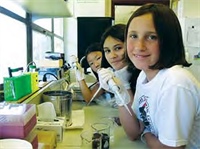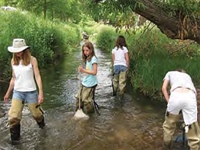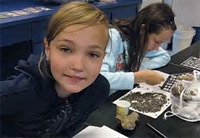How will you make the world better?
This question challenges every member of the Preston Middle School community and serves as the foundation for everything we do.
Preston Middle School is a school of science, technology, engineering, and math (STEM) located in Fort Collins, Colorado. It was named an Intel School of Distinction in Science for 2011 and received the designation of SMART Showcase Elite School for 2012. Preston increased the number of gifted and talented students by 75%, performs in the top 7% in the nation in math, and sent three Science Olympiad teams and two robotics teams to national competitions.
But it wasn’t always that way. These outcomes grew from a crisis.
Making a Link
In 2006, Preston Middle School faced many challenges. The transition from a traditional junior high school to a middle school caused community concern and apprehension about academic rigor. State accountability allowed horizontal comparison, and Preston scores were not at the top. A new school—always a magnet for mobile families—opened a mile away. And, the Poudre School District offered high-performing charter schools with boutique curricula.
Beyond these challenges particular to the community of Fort Collins, municipalities in the east were using technical education to train their students to move into newly created high-tech jobs in an effort to renew struggling urban centers.
Policymakers and the media continued to point to the country’s low rank in international testing such as Program for International Student Assessment (PISA) and Trends in International Mathematics and Science Study (TIMSS), which led Congress to examine the number and types of degrees earned in the world’s growing economies.
The 2008 CRS report to Congress, Science, Technology, Engineering, and Mathematics (STEM) Education: Background, Federal Policy, and Legislative Action, found that 17% of first college degrees in the United States are STEM degrees, compared to 52% in China and 58% in Japan.
The realization that there is a critical link between economics and STEM education led President Obama to say in his January 2011 State of the Union address: “This is our generation’s Sputnik moment!”
Taking advantage of these crises and opportunities, Preston Middle School began working to become a credible neighborhood STEM school.
Becoming a STEM School

Research is an important component of Preston’s STEM focus.
Magnet schools, schools-within-a-school, and charter schools are all models our education system uses to deliver STEM education. Preston chose a fourth model: a neighborhood STEM school open to all students.
The school’s primary goal is to create capable and confident students who can compete in and complete STEM degrees using rigorous academics, research and service, professional networking, challenging extracurricular activities, and discovery and exploration with technology integrated throughout.
Rigorous Academics. The development of mandatory state performance and academic growth testing has provided schools with valuable data to track students’ performance and target interventions around their specific needs. The most potent change at Preston, however, was attitudinal: from a belief that some students can achieve and other students can’t achieve, to a belief that all students can achieve at high levels. Learning, not time, became the constant.

Students are more motivated when they make connections to the real world.
The development of professional learning communities led to a more rigorous curriculum and higher student performance with and respectable growth in all areas and the greatest growth coming in math. Competency, not grades, is a strong motivator. Standards-based learning with common assessments give teams the tools to adjust instruction for results.
Research and Service. Research and service were added as components of Preston’s STEM school because solving real-world problems motivates students and connects learning to the real world. Student engagement skyrockets when learning is authentic and self-directed.
Beginning with the scientific method, students learn how to identify problems using data they have gathered, look for solutions that have already been tried, and design new and unique solutions. For example, in 2010, Preston joined with Lincoln Middle School to study Poudre water quality in preparation for a formal report regarding the potential environmental impact of a proposed uranium mining operation in northern Larimer County.
Professional Networking. Preston began working with the International Telementor Program (www.telementor. org) in 2010. Students choose a passion project and are matched with an expert who commits to working through the projects with the students (electronically).
For example, Preston students teamed with students in the Philippines on a reforestation project to mitigate flooding through the center of Dumaguete, Philippines, an area devastated by Typhoon Sendong.
A sixth grade science class wanted to expand the availability of water for wildlife in Selzer Gulch, Larimer County. On a Saturday morning, students, parents, and a teacher installed a guzzler (small water tank) that in the first week was visited by three black bears, a mountain lion, and a variety of bird species. And, Preston students documented a river otter, which is rare on the front range of Colorado.
Students also pursue individual passion projects. Palmer, working with a civil engineering professional, developed a flood mitigation plan for the Sevier River and presented his solution to North Dakota Governor Jack Dalrymple and the Army Corps of Engineers in December 2011.
Tyler proposed and directed efforts to obtain an Automated External Defibrillator(AED) for the school.
And Cohan was inspired to create opportunities for students with disabilities to participate in summer sports camps in his neighborhood. His camp filled immediately.
Modeling for their students, Preston staff members have conducted gratis robotics workshops in underserved areas in Texas and South Dakota. They have hosted or presented to several schools looking into STEM practices and have also presented at national conferences. Preston also hosted a STEM Educator Symposium to bring STEM educators together to learn how to build credible STEM programs.
Challenging Extracurricular Activities. Why include challenging extracurricular activities? Athletics have held center stage for years. Dean Kamen, founder of the First Lego League and inventor of the Segway scooter, said in a 1993 New York Times article, “We need to make the right heroes and role models….We need to show kids that the 200 best inventors in the world make enough money to own their own NFL team, that no one will ever make as much money with their muscles as with their mind.”
Preston has a participation rate of more than 50% factor (includes repeats) in athletics, but it also has a participation rate of 38% factor in STEM extracurricular activities, such as FIRST Robotics, MathCounts, and Science Olympiad.

Hands-on activities encourage students to explore and discover.
Discovery and Exploration. Colorado State University’s Bob Richburg, in his book Igniting Student Potential, states: “The seven words ‘See if you can figure this out’ are, metaphorically, the mating call of the brain. They are the brain’s ‘mating call’ because whenever a brain hears those words, either explicitly or implicitly, it enthusiastically responds, ‘Yes, I will try to figure it out!’”
Children are born to discover and explore. Courses and activities that allow them to try something new give them data they will use to make career decisions. Classes like Hybrid Powered Vehicles, Oceanography, Introduction to Engineering, 3D Design, and Space Mission are engaging and draw students out to participate.
Preston offers these classes in a variety of formats: as quarter classes, semester classes, and during the STEM Institute in the summer. Extended, in-depth field trips also are laboratories for exploration.
Technology Integration. Preston Middle School thrives on learning and implementing technology. Gone are the days when technology was thought of as an add-on— something that had to be taught somewhere during the lesson, usually at the end. Preston believes technology gives every student a voice, increases student engagement, develops higher-order thinking skills, and drives curriculum.
In 2007, Preston had three roaming interactive SMART Boards®. The Preston community embraced this technology because it allowed movement, engagement, collaboration, and creativity. Students and staff became dependent on SMART Boards and soon there was one in every classroom. This excitement inspired Preston Middle School to implement the latest technology whenever possible.
The purchase of iPads has given all students access to popular technology for a variety of purposes, including developing helpful apps. Students access technologies beyond the school day, which helps close the digital divide.
Research shows that students learn complex concepts easier and retain those concepts longer when learning occurs in a 3D format. A team of Preston staff members built a 3D video lab, so now students are able to learn curriculum in 3D. They are creating 3D content as well. The purchase of a 3D printer allows students to prototype their 3D work.
Preston students are learning the technological skills of the future today!
Our Hope
The Mayan calendar crisis aside, the Arlington Institute (www.arlingtoninstitute.org) identifies the following as “The World’s Biggest Problems”:
- Economic collapse
- Peak oil
- Global water crisis
- Species extinction
- Rapid climate change
The solutions to these and future problems will come from individuals with the heart and mind to make their world better. Many of these individuals are in our schools today and need to be given the opportunity to become engaged in these issues through STEM. We are excited to learn how the world will become better through STEM education!
Previously published in Middle Ground magazine, August 2012

I’m impressed by Preston’s focus on rigorous academics, research, and service, as well as its emphasis on professional networking and challenging extracurricular activities. It seems like a holistic approach to preparing students for success.